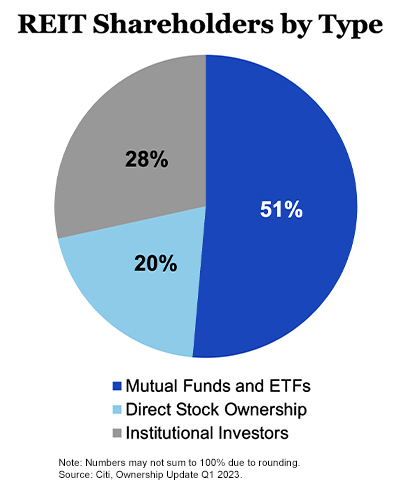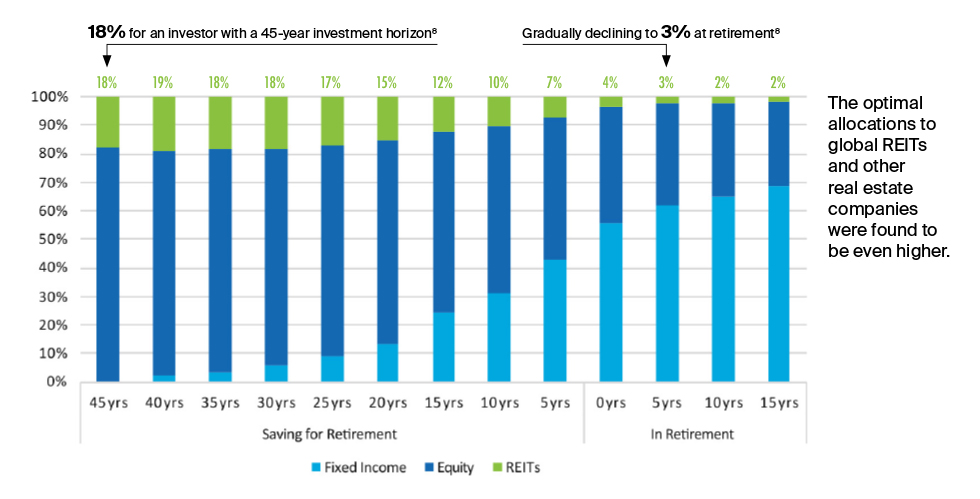
How do I Invest in a REIT?
An individual may buy shares in a REIT, which is listed on major stock exchanges, just like any other public stock. Investors may also purchase shares in a REIT mutual fund or exchange-traded fund (ETF). In fact, approximately 170 million Americans live in households invested in real estate through REITs – many accessing them through mutual funds and ETFs in their 401(k)s, IRAs, the Thrift Savings Plan (TSP), and pension plans.
Nearly 100% of target date funds, which are prevalent in 401(k) plans, have REIT allocations, and a majority of pension plans, including those for teachers, firefighters, nurses, state government employees and others, gain real estate exposure through REITs.
A broker, investment advisor or financial planner can help analyze an investor’s financial objectives and recommend appropriate REIT investments. According to a 2020 Chatham Partners study, 83% of financial advisors recommend REITs to their clients.
Investors also have the ability to invest in public non-listed REITs and private REITs.
What is an appropriate allocation to REITs?
The answer will vary based on each investor’s goals, risk tolerance and investment horizon, but here are some key insights that can help:
Multiple studies have found that the optimal REIT portfolio allocation may be between 5% and 15%.
David F. Swensen, PhD, noted CIO of the Yale endowment and author of Unconventional Success: A Fundamental Approach to Personal Investment, recommends a 15% allocation to REITs for most investors.
Further insight comes from Chatham Partners' research which found that advisors recommend allocations to REITs in the range of 4% to 12% – irrespective of the client's age – from early career to in retirement.
How does age affect the optimal REIT allocation?
As this Morningstar Funds Management Glide Path Model shows, an optimal allocation for certain investors could start at 18% for an investor with a 45-year investment horizon, gradually declining to 3% at retirement and 2% after 15 years in retirement.
How is the value of REIT shares typically assessed?
Like all companies whose stocks are publicly traded, REIT shares are priced by the market throughout the trading day. To assess the investment value of REIT shares, analysts typically consider:
- Anticipated growth in earnings per share;
- Anticipated total return from the stock, estimated from the expected price change and the prevailing dividend yield;
- Current dividend yields relative to other yield-oriented investments (e.g., bonds, utility stocks and other high-income investments);
- Dividend payout ratios as a percent of REIT FFO (see below for discussion of FFO and AFFO);
- Management quality and corporate structure; and
- Underlying asset values of the real estate and/or mortgages and other assets.
How do REITs measure earnings and ability to pay dividends?
REITs use net income as defined under the Generally Accepted Accounting Principles (GAAP) as their primary operating performance measure. Additionally, REITs use funds from operations (FFO), a measure of cash generated, as a supplemental indicator of their operating performance.
Nareit defines FFO as net income excluding gains or losses from sales of most property and depreciation of property, since real estate typically appreciates rather than depreciates. Securities analysts also use a measure called Adjusted FFO (AFFO), which adjusts FFO for rent increases and certain capital expenditures.
What factors typically drive REIT earnings growth?
Growth in REIT earnings is typically generated by higher revenues, lower costs and new business opportunities. The most immediate sources of revenue growth are higher rates of building occupancy and increased rents. Additional property acquisition and development programs also create growth opportunities, provided the economic returns from these investments exceed the cost of financing.
How do I find out what companies are REITs?
The REIT Directory provides a comprehensive list of REIT and publicly traded real estate companies that are members of Nareit. The directory can be sorted and filtered by sector, listing status, and stock performance.
How can I track the performance of REITs on an ongoing basis?
View the FTSE Nareit U.S. Real Estate Index Series and the FTSE EPRA/Nareit Global Real Estate Index Series Daily Returns and subscribe for updates.
Do I need a Schedule K-1 Tax Document to invest in REITs?
No, a Schedule K-1 is not needed to invest in REITs.


